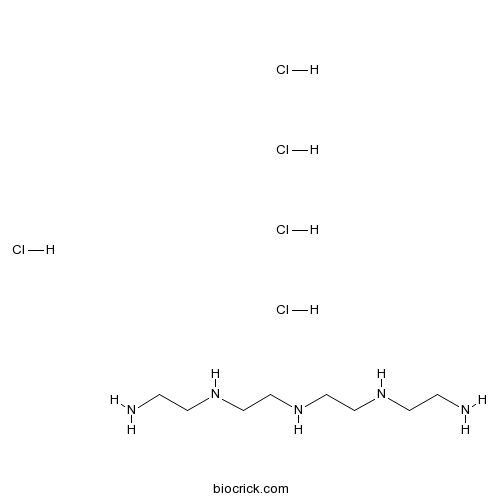Tetraethylenepentamine 5HClCAS# 4961-41-5 |

Quality Control & MSDS
3D structure
Package In Stock
Number of papers citing our products

| Cas No. | 4961-41-5 | SDF | Download SDF |
| PubChem ID | 10309252 | Appearance | Powder |
| Formula | C8H28Cl5N5 | M.Wt | 371.61 |
| Type of Compound | N/A | Storage | Desiccate at -20°C |
| Solubility | <3.72mg/mL in DMSO | ||
| Chemical Name | N'-[2-[2-(2-aminoethylamino)ethylamino]ethyl]ethane-1,2-diamine;pentahydrochloride | ||
| SMILES | C(CNCCNCCNCCN)N.Cl.Cl.Cl.Cl.Cl | ||
| Standard InChIKey | VGICAQBLDJAGSJ-UHFFFAOYSA-N | ||
| Standard InChI | InChI=1S/C8H23N5.5ClH/c9-1-3-11-5-7-13-8-6-12-4-2-10;;;;;/h11-13H,1-10H2;5*1H | ||
| General tips | For obtaining a higher solubility , please warm the tube at 37 ℃ and shake it in the ultrasonic bath for a while.Stock solution can be stored below -20℃ for several months. We recommend that you prepare and use the solution on the same day. However, if the test schedule requires, the stock solutions can be prepared in advance, and the stock solution must be sealed and stored below -20℃. In general, the stock solution can be kept for several months. Before use, we recommend that you leave the vial at room temperature for at least an hour before opening it. |
||
| About Packaging | 1. The packaging of the product may be reversed during transportation, cause the high purity compounds to adhere to the neck or cap of the vial.Take the vail out of its packaging and shake gently until the compounds fall to the bottom of the vial. 2. For liquid products, please centrifuge at 500xg to gather the liquid to the bottom of the vial. 3. Try to avoid loss or contamination during the experiment. |
||
| Shipping Condition | Packaging according to customer requirements(5mg, 10mg, 20mg and more). Ship via FedEx, DHL, UPS, EMS or other couriers with RT, or blue ice upon request. | ||

Tetraethylenepentamine 5HCl Dilution Calculator

Tetraethylenepentamine 5HCl Molarity Calculator
| 1 mg | 5 mg | 10 mg | 20 mg | 25 mg | |
| 1 mM | 2.691 mL | 13.455 mL | 26.9099 mL | 53.8199 mL | 67.2748 mL |
| 5 mM | 0.5382 mL | 2.691 mL | 5.382 mL | 10.764 mL | 13.455 mL |
| 10 mM | 0.2691 mL | 1.3455 mL | 2.691 mL | 5.382 mL | 6.7275 mL |
| 50 mM | 0.0538 mL | 0.2691 mL | 0.5382 mL | 1.0764 mL | 1.3455 mL |
| 100 mM | 0.0269 mL | 0.1345 mL | 0.2691 mL | 0.5382 mL | 0.6727 mL |
| * Note: If you are in the process of experiment, it's necessary to make the dilution ratios of the samples. The dilution data above is only for reference. Normally, it's can get a better solubility within lower of Concentrations. | |||||

Calcutta University

University of Minnesota

University of Maryland School of Medicine

University of Illinois at Chicago

The Ohio State University

University of Zurich

Harvard University

Colorado State University

Auburn University

Yale University

Worcester Polytechnic Institute

Washington State University

Stanford University

University of Leipzig

Universidade da Beira Interior

The Institute of Cancer Research

Heidelberg University

University of Amsterdam

University of Auckland

TsingHua University

The University of Michigan

Miami University

DRURY University

Jilin University

Fudan University

Wuhan University

Sun Yat-sen University

Universite de Paris

Deemed University

Auckland University

The University of Tokyo

Korea University
Tetraethylenepentamine 5HCl
- Helicianeoide B
Catalog No.:BCN2487
CAS No.:496066-89-8
- Helicianeoide A
Catalog No.:BCN2486
CAS No.:496066-82-1
- Pyromeconic acid
Catalog No.:BCN7177
CAS No.:496-63-9
- Benzofuran-2-carboxylic acid
Catalog No.:BCC8851
CAS No.:496-41-3
- Fenofibrate
Catalog No.:BCC4781
CAS No.:49562-28-9
- Estradiol heptanoate
Catalog No.:BCC8961
CAS No.:4956-37-0
- 11alpha,12alpha-Oxidotaraxerol palmitate
Catalog No.:BCN7129
CAS No.:495389-95-2
- Org 25543 hydrochloride
Catalog No.:BCC6288
CAS No.:495076-64-7
- (+)-Methysticin
Catalog No.:BCN8429
CAS No.:495-85-2
- Tigloyltropeine
Catalog No.:BCN1944
CAS No.:495-83-0
- Valtropine
Catalog No.:BCN1926
CAS No.:495-82-9
- Tropine isobutyrate
Catalog No.:BCN1923
CAS No.:495-80-7
- Robustaflavone
Catalog No.:BCN8285
CAS No.:49620-13-5
- Angelicain
Catalog No.:BCN5605
CAS No.:49624-66-0
- Isomitraphylline
Catalog No.:BCN7800
CAS No.:4963-01-3
- Simiarenol acetate
Catalog No.:BCN5606
CAS No.:4965-99-5
- ZLN005
Catalog No.:BCC4882
CAS No.:49671-76-3
- Eltrombopag
Catalog No.:BCC4968
CAS No.:496775-61-2
- Eltrombopag Olamine
Catalog No.:BCC1549
CAS No.:496775-62-3
- Crobarbatine
Catalog No.:BCN2069
CAS No.:49679-23-4
- AR-C155858
Catalog No.:BCC1367
CAS No.:496791-37-8
- HhAntag
Catalog No.:BCC1617
CAS No.:496794-70-8
- Drupacine
Catalog No.:BCN7065
CAS No.:49686-57-9
- Adarotene
Catalog No.:BCC1328
CAS No.:496868-77-0
Effects of some chelating agents on urinary copper excretion by the rat.[Pubmed:8555409]
Chem Res Toxicol. 1995 Oct-Nov;8(7):942-8.
In order to estimate the potential advantages of new chelating agents which can enhance copper excretion in the chronic copper intoxication arising in Wilson's disease, the relative ability of none chelating agents to induce the urinary excretion of copper was compared with that of D-penicillamine (DPA) and triethylenetetramine.2HCl (TRIEN), all given ip at 1 mmol/kg to male Sprague-Dawley rats. The compounds examined were as follows: tris(2-aminoethyl)-amine.3HCl (TREN), tetraethylenepentamine.5HCl (TETREN), pentaethylenehexamine.6HCl (PENTEN), 1,4,7,11-tetraazaundecane.4HCl (TAUD), 1,5,8,12-tetraazadodecane.4HCl (TADD), 1-N-benzyltriethylenetetramine.4HCl (BzTT), 4,7,10,13-tetraazatridecanoic acid.2H2SO4 (TTPA), 1,10-bis(2-pyridylmethyl)-1,4,7,10-tetraazadecane.4HCl (BPTETA), and N,N-bis(2-pyridylmethyl)-4-(aminomethyl)benzoic acid (4ABA). Of these, BzTT, TTPA, and 4ABA are new chelating agents not previously reported. The factors by which these chelating agents enhanced copper excretion over control (untreated) levels were as follows: DPA, 7.2; TREN, 1.6; TRIEN, 4.0; TETREN, 10.1; PENTEN, 7.8; TAUD, 7.8; TADD, 2.6; TTPA, 5.6; BzTT, 1.8; and 4ABA, 5.5. The results indicate that it may well be possible to develop additional chelating agents which are equal or superior to those now used in the treatment of Wilson's disease, as well as structural types whose immunological properties may be significantly different from DPA or TRIEN, the compounds currently used in the clinic for this disorder.


